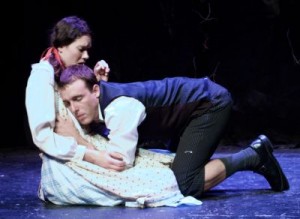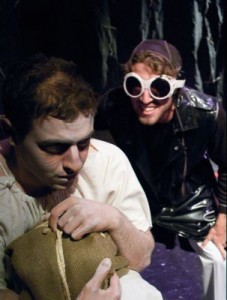NOT RECOMMENDED
German playwright Frank Wedekind’s 1891 play Spring’s Awakening was so shocking for its era that when it finally opened in New York 26 years later, it took a Supreme Court injunction to allow the show to go on … and then only for a single performance before closing. With scenes of masturbation, violence, and sex between 14-year-old characters, it is no wonder that pre-Roaring 20s audiences were shocked to the point of outrage.
These days, Wedekind’s play is best known as the source material of the smash Tony-winning Broadway rock musical Spring Awakening, with score by pop star Duncan Sheik. With the National Tour arriving at the Ahmanson Theatre in October, L.A. audiences may be curious, as I was, to take a look at the original, now being staged by The Los Angeles Theatre Ensemble.
Spring’s Awakening centers around characters in their very early teens who enjoy adolescent horseplay, frolicking in the woods, philosophizing, and wondering about sex. Wendla is a naïve girl whose lack of sex education makes her a likely victim of teen pregnancy. Melchior is a horny youth who, when asked by an obviously screwed-up Wendla to strike her with a switch, ends up pummeling her with his fists, then later has sexual intercourse with her. Moritz, Melchior’s best friend, is having his own hard time with puberty and ends up a teen suicide. Another student, Hans, beats off to a photo of a woman named Desdemona, then later makes out with a male classmate. There’s also a teen ballerina named Isle who likes to spend time on her toes in the forest.
The Los Angeles Theatre Ensemble is a company of young actors, most of whom are graduates of UCLA’s theater department. These are talented performers who should be saluted for their energy and commitment to this project.
I wish that I could be more positive about its execution, because there is clearly considerable talent behind the production. Shannon Kennedy’s rich period costumes are gorgeously designed, Francois-Pierre Couture’s dark and moody lighting design is likewise striking, as is his set, which surrounds the actors with black crepe walls made to look like tree trunks, and blood red naked branches suspended from above (along with hanging bare light bulbs). Classical minor-chorded violin music enhances the plays dark themes. Unfortunately, the negatives outweigh the positives here.
Duncan Sheik’s pop rock music would appear to be the key to the Broadway musical’s success. Filled with raucous energy and four-letter words, its contemporary sound contrasts with the 19th Century European setting to apparently stunning effect.
Without the songs, and translated from 19th century German and adapted by LATE members, Widekind’s dialog is too stilted to permit natural acting from the cast yet lacks the beauty of classical verse. That the 14-year-old characters are played by actors in their early 20s does not help in maintaining credibility, and while casting the roles of middle-aged characters with very young actors is customary in a university drama department setting, a professional production requires more age appropriate performers. Director Evan Drane stages many of the scenes with characters either seated or reclining at floor level, but as the Powerhouse Theatre seats are only slightly raked, only audience members in the front row can get a clear view of what is happening on stage without much head craning. It’s also occasionally difficult to hear the actors, who sometimes forget that projection is an essential part of stage acting. Though the first act is fairly straightforward, despite a number of lengthy (and stagy) soliloquies delivered directly to the audience, after intermission things turn decidedly bizarre, with a rather weird scene involving a trio of elderly teachers in chalk covered caps and gowns, Moritz’s return as a ghost carrying his head in the crook of his arm, and the arrival of an otherworldly man in black leather coat and huge aviator goggles. I didn’t get it.
The cast members cannot be faulted for their commitment to this project. Eleanor van Hest, Morgan Early, Luke Bailey, Nick McDow, David Hassett, Matthew Schueller, Isaac Wade, Kyle Cadman, Danika Sudik, Catherine Talton, Olivia Choate, and Jen Bailey are actors whose work I look forward to seeing in a stronger vehicle. Wade particularly stands out in a powerful turn in the second act as does Choate.
The Los Angeles Theatre Ensemble deserves highest marks for their dedication and for taking on the challenge of reviving Widekind’s original script for contemporary audiences. I am now more interested than ever in discovering why the Broadway adaptation succeeds where this non-musical version, unfortunately, does not.
Powerhouse Theatre, 3116 2nd Street, Santa Monica
www.latensemble.org.
–Steven Stanley
July 3, 2008
Photos: Albert Meijer




 Since 2007, Steven Stanley's StageSceneLA.com has spotlighted the best in Southern California theater via reviews, interviews, and its annual StageSceneLA Scenies.
Since 2007, Steven Stanley's StageSceneLA.com has spotlighted the best in Southern California theater via reviews, interviews, and its annual StageSceneLA Scenies.







 COPYRIGHT 2025 STEVEN STANLEY :: DESIGN BY
COPYRIGHT 2025 STEVEN STANLEY :: DESIGN BY